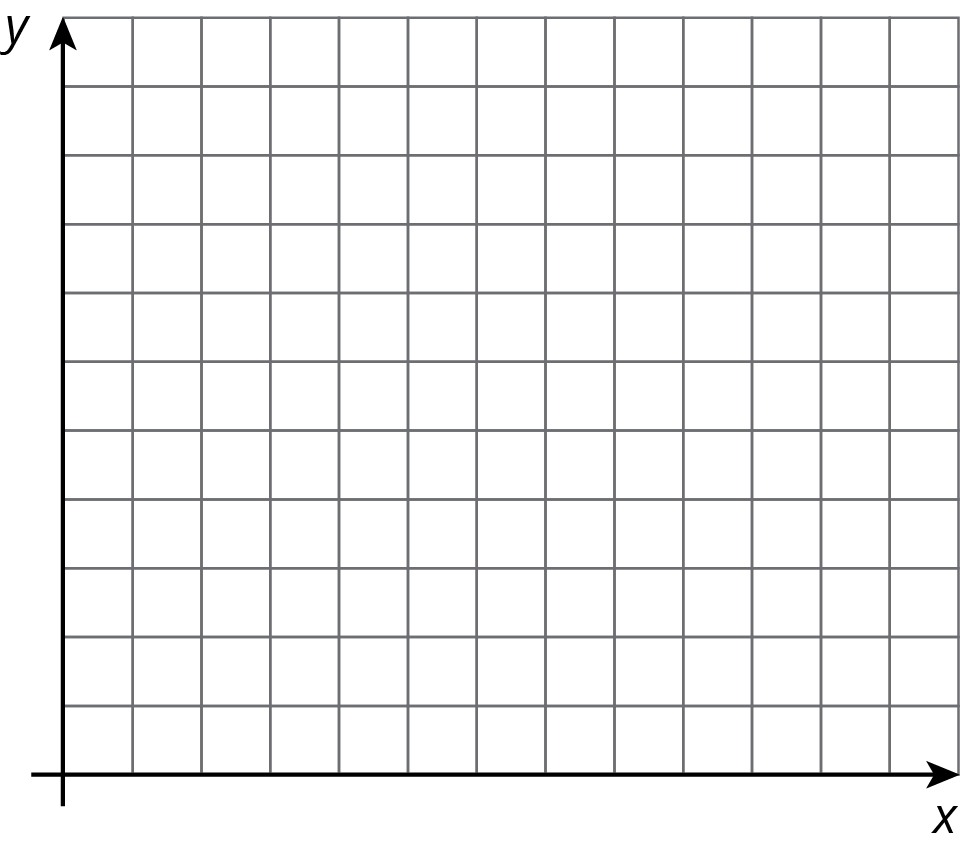Lesson 14
Using Linear Relations to Solve Problems
14.1: Buying Fruit (5 minutes)
Warm-up
Students write expressions and equations representing total cost. The purpose of this activity is to support students in writing the equation for the “Ordering Fish” activity.
Launch
Arrange students in groups of 2. Display questions for all to see. Give 2 minutes quiet think time, followed by 2 minutes partner discussion then whole-class discussion.
Student Facing
For each relationship described, write an equation to represent the relationship.
- Grapes cost $2.39 per pound. Bananas cost $0.59 per pound. You have $15 to spend on \(g\) pounds of grapes and \(b\) pounds of bananas.
- A savings account has $50 in it at the start of the year and $20 is deposited each week. After \(x\) weeks, there are \(y\) dollars in the account.
Student Response
For access, consult one of our IM Certified Partners.
Anticipated Misconceptions
Some students may not be sure how to approach writing the scenario as an equation. For these students, suggest that they make a table of possible prices based on the amount of fruit purchased.
Activity Synthesis
The purpose of this discussion is to have students explain strategies for writing equations for real-world scenarios. Ask students to share what they discussed with their partners by asking:
- “What did each of the variables mean in the situations?” (Since we want a price based on the number of pounds of fruit, \(b\) and \(g\) represent the amount of bananas and grapes purchased. For the savings account, the \(x\) was the number of weeks, and the \(y\) was number of dollars.)
- “Was the slope for each of these equations positive or negative? Why does that make sense with the scenario?” (For the fruit, the slope was negative, which makes sense because if you buy more of one fruit, you have to buy less of the other. For the savings account, the slope is positive, which makes sense because the more weeks go by, the more money will be in the account.)
14.2: Five Savings Accounts (25 minutes)
Activity
Given a graph with five lines representing changes in bank account balance over time, students write equations and interpret how points represent solutions. The activity also connects to and contextualizes students’ prior understanding of slope and intercepts, and lays the foundation for the coming unit on systems of equations by considering what points of intersection of lines and non-intersecting lines represent.
Launch
Display the image from the lesson for all to see and ask the students to consider line \(a\). Invite 2–3 students to describe in words what line \(a\) shows. If no students bring it up, tell students that they saw this line before in the warm-up, and they wrote an equation for it. Instruct students that for #1, they should not choose line \(a\).
Arrange students in groups of 3–4. Groups work for about 10 minutes, followed by a whole-class discussion.
Supports accessibility for: Memory; Conceptual processing
Design Principle(s): Support sense-making; Cultivate conversation
Student Facing
Each line represents one person’s weekly savings account balance from the start of the year.

- Choose one line and write a description of what happens to that person's account over the first 17 weeks of the year. Do not tell your group which line you chose.
- Share your story with your group and see if anyone can guess your line.
-
Write an equation for each line on the graph. What do the slope, \(m\), and vertical intercept, \(b\), in each equation mean in the situation?
- For which equation is \((1,70)\) a solution? Interpret this solution in terms of your story.
- Predict the balance in each account after 20 weeks.
Student Response
For access, consult one of our IM Certified Partners.
Activity Synthesis
Students should understand that points on a line show solutions to the equation of the line. Discuss with students:
- “What can we say about the points where two lines cross?” (The accounts had the same amount of money at the same time.)
- “How do the slopes of the lines help to tell the story from the graph?” (The slope tells us whether a person is spending or saving each week.)
- “What does your answer to question 3 tell us about their rates of saving?” (By knowing the value of the slope, we can compare who is spending or saving more quickly or more slowly.)
14.3: Fabulous Fish (20 minutes)
Activity
Students represent a scenario with an equation and use the equation to find solutions. They create a graph (either with a table of values or by using two intercepts), interpret points on the graph, and interpret points not on the graph (MP2).
Launch
Allow about 10 minutes quiet think time for questions 1 through 4, then have students work with a partner to discuss questions 4 and 5. Look for students who define the variables or label the axes differently. This can be an opportunity to discuss the importance of defining what quantities your variables represent and that different graphs can represent the same information.
Design Principle(s): Support sense-making; Maximize meta-awareness
Student Facing
The Fabulous Fish Market orders tilapia, which costs $3 per pound, and salmon, which costs $5 per pound. The market budgets $210 to spend on this order each day.
- What are five different combinations of salmon and tilapia that the market can order?
- Define variables and write an equation representing the relationship between the amount of each fish bought and how much the market spends.
-
Sketch a graph of the relationship. Label your axes.

-
On your graph, plot and label the combinations A—F.
A B C D E F pounds of tilapia 5 19 27 25 65 55 pounds of salmon 36 30.6 25 27 6 4 -
Which of these combinations can the market order? Explain or show your reasoning.
- List two ways you can tell if a pair of numbers is a solution to an equation.
Student Response
For access, consult one of our IM Certified Partners.
Anticipated Misconceptions
If students let \(x\) be pounds of salmon, then the equation would be \(5x + 3y = 210\) and the coordinates would be reversed. The intercepts of the graph would be \((0,70)\) and \((42,0)\). This is a good place to mention the importance of defining what quantities your variables represent.
Activity Synthesis
Ask students to share some strategies for graphing and features of their graphs. Invite 2–3 students to display their graphs. Consider asking:
- "Was the slope of the line positive or negative? Why does that makes sense in this situation?" (In this relationship, as one quantity increases the other must decrease in order to keep the sum \(3x + 5y\) constant.)
- "What was your strategy for graphing the relationship?" (Plotting points from question 1, using the table, figuring out the intercepts and connecting the line)
- "Why does it make sense for the graph to be only in quadrant I?" (You cannot purchase a negative amount of fish, so the \(x\) and \(y\) values cannot be negative.)
- "How is this situation different from the apples and oranges problem in a previous lesson?" (Buying \(\frac12\) pound of fish is reasonable while buying \(\frac12\) of an apple probably is not. )
Briefly reiterate key concepts: If a point is not on the graph of the equation then it is not a solution. The ordered pairs that are solutions to the equation all make the equation true and are all found on the line that is the graph of the equation.
A discussion could also include the detail that orders that are less than $210 can also be considered to work, because there is money left over. That gives an opportunity to discuss the shape of the graph of \(3x + 5y \le 210\).
Lesson Synthesis
Lesson Synthesis
Ask students to consider the real-world situations described in this lesson. Discuss:
- “Give an example of a solution to an equation that doesn’t make sense in the context it represents.” (Some values might not make sense in the context, like negative values. A length cannot be negative, for example.)
- “If some values make sense in the equation but not in the context, how could this impact the graph?” (We might only draw part of the line or draw some of the points that lie on the line.)